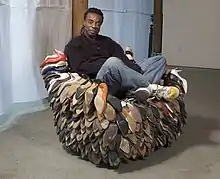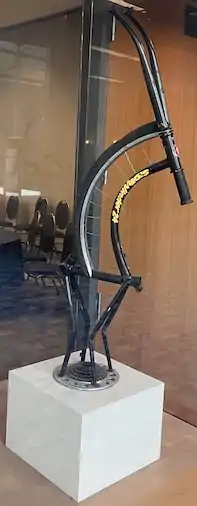Willie Cole
Willie Cole (born 1955 in Somerville, New Jersey) is a contemporary American sculptor, printer, and conceptual and visual artist. His work uses contexts of postmodern eclecticism, and combines references and appropriation from African and African-American imagery. He also has used Dada’s readymades and Surrealism’s transformed objects, as well as icons of American pop culture or African and Asian masks.
Willie Cole | |
|---|---|
 | |
| Born | Willie Cole January 3, 1955 New Jersey, United States |
| Nationality | American |
| Education | Bachelor of Fine Arts from the School of Visual Arts, New York |
| Known for | Sculpture, Painting, Visual Arts |
| Awards | 2006 David C. Driskell Prize |
| Website | http://www.williecole.com/ |
Works

Cole is best known for assembling and transforming ordinary domestic and used objects such as irons, ironing boards, high-heeled shoes, hair dryers, bicycle parts, wooden matches, lawn jockeys, and other discarded appliances and hardware, into imaginative and powerful works of art and installations.
In 1989, Cole garnered attention in the art world with works using the steam iron as a motif. Cole imprinted iron scorch marks on a variety of media, showing not only their wide-ranging decorative potential but also to reference his Cole’s African-American heritage.[1] He used the marks to suggest the transport and branding of slaves, the domestic role of black women, and ties to Ghanaian cloth design and Yoruba gods.[2]
Through the repetitive use of single objects in multiples, Cole’s assembled sculptures acquire a transcending and renewed metaphorical meaning, or become a critique of our consumer culture. Cole’s work is generally discussed in the context of postmodern eclecticism, combining references and appropriation ranging from African and African-American imagery, to Dada’s readymades and Surrealism’s transformed objects, and icons of American pop culture or African and Asian masks, into highly original and witty assemblages.[3] Some of Cole’s interactive installations also draw on simple game board structures that include the element of chance while physically engaging the viewer.[4]
His "Anne Klein With a Baby in Transit," from 2009, uses discarded high-heeled shoes to depict a mother and child. The well-worn black shoes combine to recall traditional African sculptures. It was a gift from the Brenden Mann Foundation to the Minneapolis Institute of Arts.[5]
Cole's work is included in the Afrofuturist Period Room exhibition Before Yesterday We Could Fly at the Metropolitan Museum of Art.[6]
Shows
Solo shows
- 2012, Highpoint Editions, Minneapolis, Five Beauties Rising: New Prints by Willie Cole
Group shows
- 2017, Highpoint Editions, Minneapolis, Operation Chromebody
- 2017, Alexander and Bonin, New York, Walker Street Summer
- 2015, MCA Chicago, Chicago, Surrealism: The Conjured Life
- 2012, Tamarind Institute, Albuquerque, Afro: Black Identity in America and Brazil[7]
Life
Early life
Willie Cole, a native of Sommerville, New jersey later moved to Newark, New Jersey, where he found a passion for the field of arts. He later took classes at the Newark Museum.[8] After attending the museum for lessons he was accepted to the Arts High School of Newark.[9] He attended the Boston University School of Fine Arts, received his Bachelor of Fine Arts degree from the School of Visual Arts in New York in 1976, and continued his studies at the Art Students League of New York from 1976 to 1979.
Career
In 1978, he found work as a graphic designer for the Queens County Borough Hall[10] as part of the Comprehensive Employment and Training Act's employment of artists.[11] Further pursuing his passion, Willie later progressed and hosted his first major gallery show, located at Franklin Furnace Gallery in New York City,[12] in 1989. In 1990 he participated as the Artist-In-Residence, In the Studio Museum,[13] located in Harlem, New York. Willie Cole is the recipient of many awards, including the 2006 David C. Driskell Prize, the first national award to honor and celebrate contributions to the field of African-American art and art history, established by the High Museum of Art in Atlanta, Georgia.[14] Cole is represented by Alexander and Bonin Gallery[15] in New York; and by Guido Maus, beta pictoris gallery / Maus Contemporary[16] in Birmingham, AL.
In 2023, Cole's work With a Heart of Gold, was acquired by the Pérez Art Museum Miami through the institution's Fund for Black Art program.[17][18]
Museum collections
Willie Cole's work is found in numerous private and public collections and museums around the world, including:
- Albright-Knox Art Gallery, Buffalo, N.Y.
- Allen Memorial Art Museum, Oberlin College, Oberlin, Ohio
- American Academy of Arts and Letters, New York City
- Art Gallery of Ontario, Toronto, Canada
- Asheville Art Museum, Asheville, North Carolina
- Baltimore Museum of Art, Baltimore, Md.
- Birmingham Museum of Art, Birmingham, Ala.
- Bronx Museum of the Arts, New York City
- Cleveland Museum of Art, Cleveland, Ohio
- The College of New Jersey, Ewing Township, N.J.
- Columbia Museum of Art, Columbia, S.C.
- Columbus Museum of Art, Columbus, Ohio
- Dallas Museum of Art, Dallas, Texas
- Davis Museum and Cultural Center, Wellesley College, Wellesley, Mass.
- Detroit Institute of Arts, Detroit, Mich.
- FRAC-Lorraine, Metz, France
- Herbert F. Johnson Museum of Art, Ithaca, N.Y.
- High Museum of Art, Atlanta, Ga.
- Hunter Museum of American Art, Chattanooga, TN
- Iris & B. Gerald Cantor Center for Visual Arts, Stanford University, Palo Alto, Calif.
- Metropolitan Museum of Art, New York
- Memorial Art Gallery, University of Rochester, New York
- Minneapolis Institute of Arts, Minneapolis, Minn.
- Montclair Art Museum, Montclair, N.J.
- Muscarelle Museum of Art, Williamsburg, VA
- Museum of Contemporary Art, Chicago
- Museum of Modern Art, New York City
- National Gallery of Art, Washington, D.C.
- New Britain Museum of American Art, New Britain, Conn.
- New Jersey State Museum, Trenton
- New York Public Library, New York City
- Newark Museum, Newark, N.J.
- North Carolina Museum of Art, Raleigh, NC
- Norton Museum of Art, West Palm Beach, Fla.
- Orlando Museum of Art, Orlando, Fla.
- Palmer Museum of Art, Penn State University, University Park, PA
- Pennsylvania Academy of Fine Arts, Philadelphia
- Pérez Art Museum Miami, Fla.
- Philadelphia Museum of Art, Philadelphia
- Saint Louis Art Museum, St. Louis, Mo.
- San Antonio Museum of Art, San Antonio, Tx
- Sheldon Memorial Art Gallery, University of Nebraska, Lincoln
- Southeastern Center for Contemporary Art, Winston-Salem, N.C.
- Speed Art Museum, Louisville, Ky.
- Spencer Museum of Art, Lawrence, KS.
- The Studio Museum in Harlem, New York, NY.
- Tamarind Institute, University of New Mexico, Albuquerque
- Tampa Museum of Art, Tampa, Fla.
- Tweed Museum of Art, University of Minnesota, Duluth
- University Art Museum, University of California, Santa Barbara
- Virginia Museum of Fine Arts, Richmond
- Walker Art Center, Minneapolis, Minn.
- Whitney Museum of American Art, New York City
- Worcester Art Museum, Worcester, Mass.
- Yale University Art Gallery, New Haven, Conn.
References
- Article on Willie Cole’s 2007 exhibit at the Frye Museum of Art
- "Cole, Willie". Oxford Art Online.
- Worcester Art Museum Catalogue of Cole’s 2005-2006 exhibit
- Anxious Objects: Willie Cole's Favorite Brands By Smith, Patterson, Leslie King-Hammond, Lowery Stokes Sims. Published 2006. Montclair Art Museum Publn.
- "Anne Klein With a Baby in Transit".
- "In 'Before Yesterday We Could Fly,' Visions of a Fictive Black Future Take Flight at the Met". Vogue. 2021-11-02. Retrieved 2022-02-05.
- "Willie Cole - 111 Artworks, Bio & Shows on Artsy".
- "Willie Cole's Biography". The HistoryMakers. Retrieved 2022-04-28.
- "Homepage". Arts High School. Retrieved 2022-04-28.
- "Queens Borough Hall - Department of Citywide Administrative Services". www1.nyc.gov. Retrieved 2022-04-28.
- Bomb magazine, “Oral History Project,” interview with Nancy Princenthal, December 12, 2019
- "Franklin Furnace: Performance is Public". www.bklynlibrary.org. 2019-05-06. Retrieved 2022-04-28.
- "The Studio Museum in Harlem". The Studio Museum in Harlem. Retrieved 2022-04-28.
- Willie Cole's David C. Driskell Prize
- "Alexander and Bonin". Alexander and Bonin. Retrieved 2017-09-21.
- "maus contemporary - Willie Cole". www.mauscontemporary.com. Retrieved 2017-09-21.
- "Pérez Art Museum Miami Announces Tenth Anniversary of Art + Soul Celebration, Honoring Actor and Activist Jesse Williams • Pérez Art Museum Miami". Pérez Art Museum Miami. Retrieved 2023-02-24.
- Straaten, Laura van (2023-02-23). "Willie Cole's Ecological Interventions Turn Trash Into Art". The New York Times. ISSN 0362-4331. Retrieved 2023-02-24.